

Collector’s Showcase: Mike Curotto
Jim Messina’s Vintage Drums Talk.com


1928-34 SLINGERLAND 6.5x14 WALNUT/ARTGOLD TONE FLANGE ARTIST MODEL
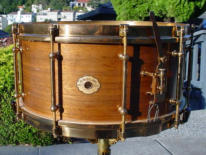
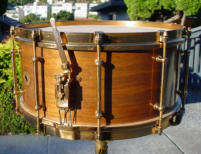
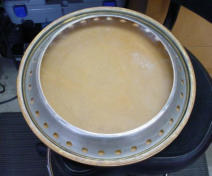
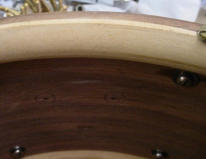
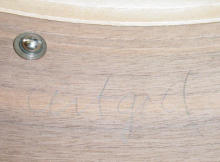
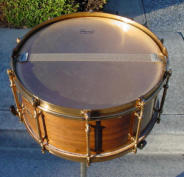
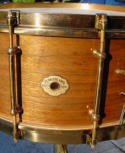
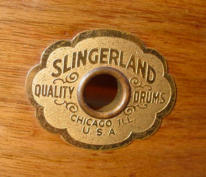

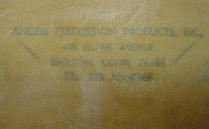
The Shell:
The solid walnut shell (maple reinforcement rings) was in great shape and only needed a slight coat of lemon oil to
clean it up. Slingerland solid walnut shells were introduced in 1928 and lasted until 1939 which is generally considered
the end of the solid shell era for a number of drum manufacturers...for a while at least, notwithstanding the Radio
Kings of course. A nice leftover artifact from yesteryear is the factory penciled "artgold" on the inside of the shell. All 10
of the brass flat head wood screws were intact and in very good shape. The Tone Flange on this drum is the aluminum
version with holes and fits nicely on to the shell, which is not always the case as these Tone
Flanges can be very finicky at times...more like a giant pain in the butt.
The Hardware:
The Artgold hardware was in very good shape with less than normal wear, so a restoration was not needed, just a light
cleaning with Simple Green and a finish coat of 3-In-One oil.
Anyone that owns a drum like this is well aware of the "pure joy" we all share when we attempt to put a top (batter) head
onto the Tone Flange...and then hope that the double flange top rim will fit over the oversized batter head. Well, I lucked
out on this one, there was a funky old Duraline type batter head already attached to the Tone Flange and the top rim fit
nicely onto the batter head so I counted my blessings and paid my homageto the god of "Oversized Heads That Fit Onto
Tone Flanges And Still Allow Double Flange Rims To Fit". A nice Slingerland slunk head and the original James Snappi
wires rounded out this cleaning.

*The Broadcaster Model was very short-lived so for those of you that may not be familiar with this model here is a short history
and background data regarding the Slingerland Broadcaster Model. The following is from Rob Cook's Slingerland Book (first
edition): "The Broadcaster was evidently a forerunner of the Radio King, the strainer is a very early Radio King style strainer
and the lugs do not have inserts. (The tension rods thread directly into the lugs.) The muffler was the single-pad style Harold R.
Dodd muffler." Thanks again to Rob Cook. I have also read that Slingerland was legally forced to discontinue using the word
"Broadcaster" (with a "c") as the Fred Gretsch Co. had been using the name "Broadkaster" (with a "k") on their drums way
before Slingerland and therefore the court ruled in favor of Gretsch that Slingerland's Broadcaster was too close
sounding/looking to Gretsch's Broadkaster.
The Shell:
The Sparkling Green wrap was in pretty good shape with very few of those black "cancer" spots that usually show up on these
older Green Sparkle drums. I was able to get a few layers of age off of the wrap with my Maguire's cleaning/polishing regime
and the Sparkling Green finish came back to life. The solid maple shell interior was also in good shape and only needed a
very light cleaning. The cloud badge was tight and weathered the last 75+ years pretty well.
The Hardware:
I'll call it Slingerland Artgold but the hardware finish on this snare drum really resembles the Ludwig & Ludwig Classic Gold
(brass plating with gold lacquer) finish that L&L used on their early-mid 1930s Black Beauties. There was a lot of Artgold
present but an equal amount of age and tarnish. I haven't figured out how to duplicate the Classic Gold finish yet so the
decision was to leave the hardware as is and just do a simple cleaning with a light coat of gold lacquer to seal everything to
prevent any further tarnishing. The 16 tension rods were not correct so I went to my stash and found the correct tension rods
but these had to be brass plated, antiqued and lacquered. Thanks again to Les and Brian Hadnagy of Avenue Plating for the
brass plating and antiquing. The threaded snare gates have the letter "A" stamped on the inside (not seen) part of the rim and
gates. This is called a "manufacturer's cartouche", thanks to Slingerland expert Dr. Carl Wenk for that information. I'd love to
know if those type of markings are under the riveted snare gates, feel free to send photos. The Slingerland Broadcaster
engraving on the top rim is pretty faint but it is there. All in all, the "carpet matches the curtains" pretty well on this drum.
Of-the-era calf heads and extension wires rounded out this cleaning/restoration. Enjoy!
1934-35 SLINGERLAND 6.5 x 14 SPARKLING GREEN/ARTGOLD *BROADCASTER MODEL
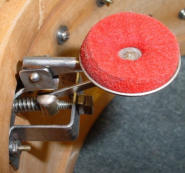
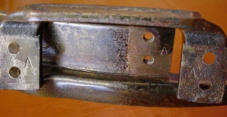

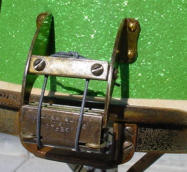
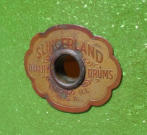
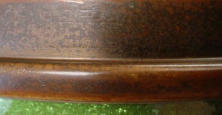
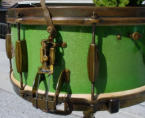
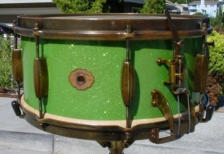

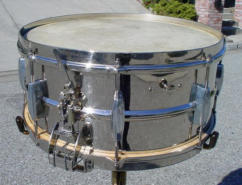
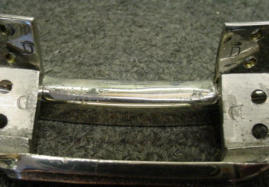
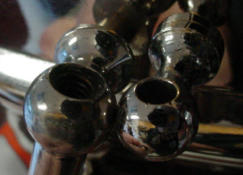

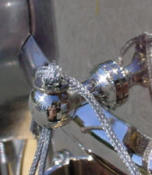
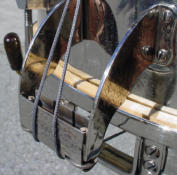
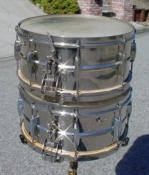

1934-35 SLINGERLAND 6.5 x 14 NOB *BROADCASTER MODEL

1937 LUDWIG & LUDWIG 6.5 x 15 BLACK DIAMOND PEARL
SUPER-LUDWIG MODEL (SPECIAL ORDER)

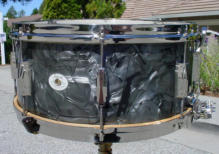
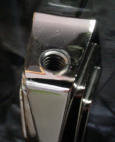
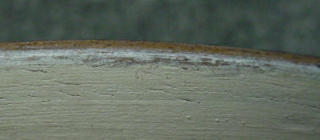
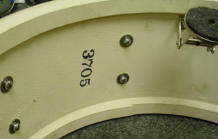
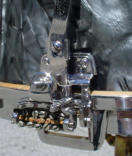
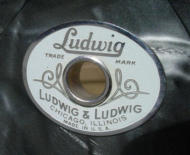
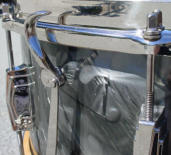
I recently got this drum from my good friend and fellow collector Bill Wanser. The drum is all original except for the top and
bottom heads. There is a special story that comes with this drum. Bill Wanser has allowed me to use his words regarding this
drum: "1. They did not offer this size drum in this configuration in the 1937 catalog. That is they did not offer a 'Super Ludwig'
in a 15" size, metal or wood shell in the Imperial lug era of the 1930's. This would have also been close to the end of the use
of the tapped Imperial lugs...2. There are no snare guards. Imperial lug era Supers used a bottom rim with flanges allowing
the guards to be attached to the rim and since they did not produce these rims for a 15" drum they could not attach snare
guards. Clip-on type snare guards for the 10 tube lug era would not fit on a 15", 8 lug drum. This is the only 15" metal rim
with drop gates on a Ludwig drum from this era that I've seen. My guess is that the rims are Leedy, since Leedy produced
the Parallel Model (they look the same as those that Leedy used on their Parallel) in an 8 lug, 15" size as late as 1936 while
Ludwig last made 15" concert drums in the tube lug era (1935) and they were clip style rims. This rim also does not have
Ludwig Super engraved or stamped on the bottom rim. 3. This drum definitely does not fit anything offered in a Ludwig
catalog and from the conversation I had with the person who originally found this drum, and who spoke to the original owner,
this was a 'Special Order' drum. The gentleman (original owner) said he had discussed his need for a drum appropriate for
playing with a 'Band' with William Ludwig Sr. and that WFL Sr. suggested this size drum with a wood shell and said that they
would make this drum for him." Thanks Bill.
THE SHELL:
The date stamp is 3705 so we are at May of 1937. L&L Black Diamond Pearl showed up in 1936 so we are good there. The
shell looks to be solid mahogany with the white interior. The BDP is very clean but I still wanted to get my hands on it to do a
little "Curotto-izing" to it. I was able to brighten up the BDP a bit more. The white interior needed nothing done to it. The white
enamel L&L badge is very clean with a tight grommet.
THE HARDWARE:
The nickel plating is in great shape and cleaned/polished up nicely. The Super mechanism is all there and works fine. The 8
Imperial lugs are the Anniversary-era tapped lugs; one lug was stripped at one end but my friend Al Schneider (the original
Drum Doctor) was able to put one of those hela-coils in there and saved the day.
Thanks again to Bill Wanser for a nice pair of top and bottom of-the-era calf heads.
Enjoy!
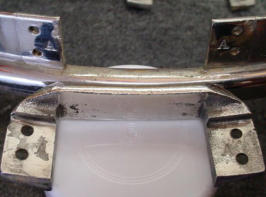
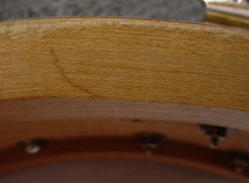
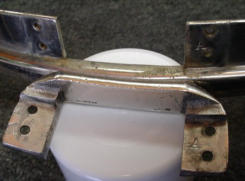
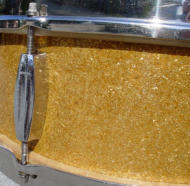
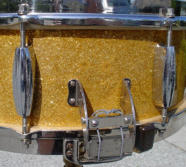
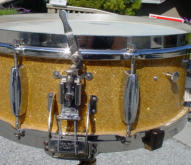
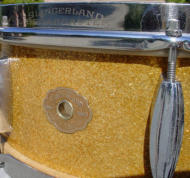
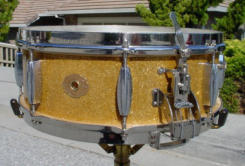
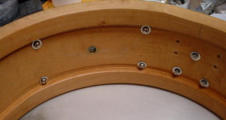

1935 SLINGERLAND 5x14 SPARKLING GOLD BROADCASTER MODEL
The Shell:
The Sparkling Gold is in remarkable shape with minimal fade and no "cancer spots" but I wanted to clean and polish it up
a little more. I was able to get a few layers of schmutz off of the shell and the Gold Sparkle brightened up nicely. The
solid maple shell is in great shape with no re-ring separation and the shell is in round with a clean cloud badge. The
interior is in excellent condition with a tight grommet and needed nothing done to it.
The Hardware:
Yeah, yeah, I know this was standard operating procedure at the Slingerland factory but the chrome plated Streamlined
lugs vs. the rest of the nickel plated hardware still bugs the hell out of me. It's just wrong; so in the interest of authenticity
and historical accuracy I left the lugs as is but I held my nose doing it. Two of the tapped Streamlined lugs were stripped
at one end, not to fear, my good friend Al Schneider (the original Drum Doctor) once again came to the rescue and was
able to hela-coil the stripped threads. Most of the nickel hardware was in very good shape, only the snare bridges showed
more than normal wear but everything polished up nicely. There is a nice clean Slingerland Broadcaster engraved logo
on the top rim and the manufacturer's cartouches are present at the snare gates.
Of-the-era top and bottom Slingerland calf heads and Snappi snare wires rounded
out this fairly easy cleaning and light restoration.
Enjoy!

1929-30 LUDWIG & LUDWIG 5x14 WMP SUPER-SENSITIVE MODEL
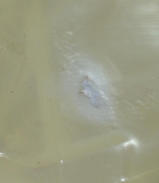
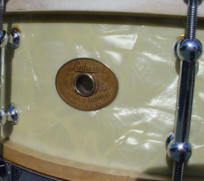
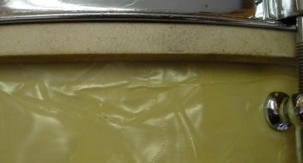
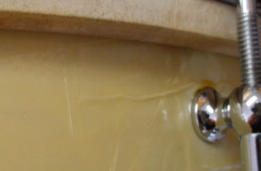
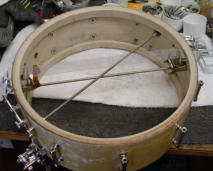
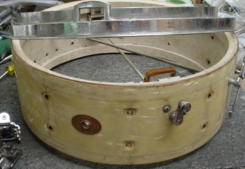
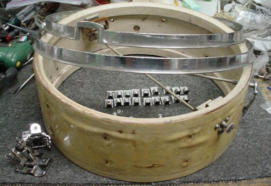
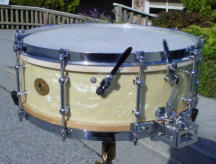
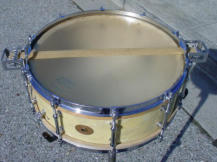
The Shell:
As the photos show, the WMP was bubbled in a few areas, fortunately at the back of the drum and away from the badge.
I'm not sure what caused this but most likely it was caused by trying to fit an ill-fitting batter head or the glue in those areas
just weakened via bad weather/exposure or simply just not enough glue in the area when it left the factory. Enter Al
Schneider (The Original Drum Doctor) to the rescue. Al was able to employ the very risky "hot iron and dry cloth technique"
to the shell. I trust Al with this type of repair but I always like to "remind" him that he is working on a very expensive and rare
snare drum; nothing like adding a little more pressure to the situation. I am very happy with the outcome as the only other
way to repair the areas would have been to completely remove the WMP wrap/badge/grommet and hope that the wrap
comes off in one piece and that you could realign the wrap to match the hole patterns. The WMP pearl cleaned up and
polished up nicely after the repair to the WMP wrap. There was a small divot in the panel left of the badge but a dollop of
white pearl nail polish cleaned it up decently. The white interior was pretty dirty and cleaned up as best as could be expected.
The L&L oval badge is clean with a tight grommet.
The Hardware:
Chrome plating was invented in 1929 and became another L&L cataloged option in 1930 along with the existing cataloged
nickel plated, Artgold and gold plated finishes.The chrome hardware on this snare drum was pretty dirty and grimy but
Simple Green and Cape Cod Polishing Cloths do the trick every time. Both the Super and Sensitive mechanisms work fine.
The "Super Sensitive" on the bottom rim is the 1930 stamped version as compared to the 1929 engraved version. I've
talked to John Aldridge and Bill Wanser about this and we agree that the earliest versions (1929) were engraved and the
later versions (1930) were stamped. We are only talking a year difference here (aside from the Super-Sensitive 1929-36)
as the New Era-Sensitive, Standard-Sensitive and Super-Power models (1929-30) were only around for a very short
period of time, were only mentioned in the Fall 1929 Ludwig Drummer Magazine, never made it to an L&L catalog and
therefore are extremely rare.
Of-the-era Ludwig calf heads plus the original Super (gut) and Sensitive wires completed this restoration.

1930-33 LEEDY 7x14 NOB RELIANCE ALL METAL MODEL
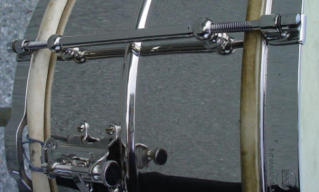
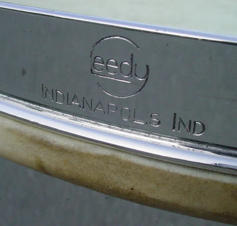
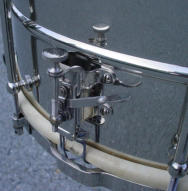
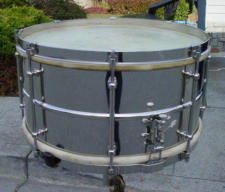
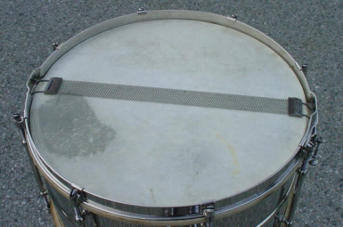
The Shell:
Per the 1930s Leedy catalog, this is the "recently improved version that now has 8 lugs and single flanged counter hoops."
I'm calling it 1930-33 because the 1930 Leedy catalog is the first showing of an 8 lug all metal Reliance Model and the 1934
Leedy catalog is the first showing of the round Reliance black badge. This shell is drilled for 8 lugs and has no badge so
1930-33 it is. A special thanks goes to Bill Wanser for helping me to accurately date this drum. The 1930 and 1934 catalogs
only mention an all metal 5x14 model so there's a little mystery here but Leedy did offer 4x14, 5x14, 6x14 and 7x14 all metal
Multi-Models and Professional Models, this I can verify because I own all of those sizes and models. The shell is the spun
brass, seamless, double air vent, single bead shell. From what I am told, the 7x14 size is Leedy's rarest size, that's why I
bought this drum. The shell has no dings and the nob is in great shape and needed only normal cleaning and polishing.
The Hardware:
The 8 Leedy tube lugs measure 4 1/4" center to center which is 5/8" longer than the 3 5/8" c-c Ludwig & Ludwig tube lugs
that were outfitted on an L&L 6.5x14 snare drum of the same era. It's curious (at least to me) as to how the ratio of shell
depth vs. tube lug length was calculated at both companies...ok, back to earth. The Presto strainer works fine but is not the
sturdiest strainer and I wouldn't trust it for any type of heavy duty playing. All of the nickel hardware is in very good shape
and was easy to clean and polish. The top rim has a nice, deep Leedy Indianapolis stamp.
Of the era calf heads and Snappi wires rounded out this cleaning/restoration.
All in all a pretty majestic looking snare drum.

Hi all,
Another one from the fertile waters of Ebay. It is my goal to someday have a museum of rare American-made drums. Part
of the museum would be old snare drums that have maybe fallen through the cracks of popularity but are still cool like
Duplex, C. G. Conn, Bower, Nokes & Nikoli, Ditson, Stromberg, Frisco, York, W&A, Wilson and the drum presented here
today: A. "Page" U.S.A. I am glad that there is an identification stamp on the top and bottom rims or I would know nothing
at all about this drum. I always welcome any added information so weigh-in if you want to.
The Shell:
I thought that I was buying a white enamel over brass snare drum and that's what showed up. Unfortunately the white
enamel is an after-market job. The exterior was somewhat believable but the interior told the tale so I stripped the white
enamel down to the brass shell and Brian Hadnagy of Avenue Plating gave it a shot of clear lacquer to preserve the age
of the shell. I decided to leave the brass shell as is because that was probably what it looked like before the white enamel
was applied (read slopped) onto the shell. There were a number of dings and dents in the shell that I was able to take
care of but there was one huge dent that needed professional help. One needed to really go out of their way to produce a
dent like this one; think yesteryear fraternity party, free flowing booze and a 3rd story window as the perfect launching
pad. Les Hadnagy of Avenue Plating came through once again as can be seen in the before/after photos. The shell is a
one-piece brass, single bead shell that is somewhat crude and light-weight with a weak looking seam. There are no snare
beds. I am not sure of the reasoning behind a 5 1/4" shell vs. a 5" shell.
The Hardware:
All of the hardware is nickel plated and I chose to do a simple cleaning, just to keep everything real. The most striking
pieces of hardware were the 6 lugs. I have never seen lugs like these; they are cast metal, tapped (12-24) with no inserts
(not unlike the 1935-36 Ludwig & Ludwig Imperial or Slingerland Broadcaster/early RK Streamlined lugs) and in lieu of a
screw, the threaded part (8-32) is attached to the lug. These lugs seem to significantly pre-date the aforementioned L&L
and Slingerland lugs. The lugs are notched in order to clear the shell bead, they fit but aesthetically they look really bad.
The lug attachment washers are very unique and look like some type of gear/sprocket. A few had what looks like an
errant hole in them. The butt plate looks like the 12-hole "tray" type used on the 1912 L&L All Metal Shells (amongst
others) but is a little more crude looking and is totally cock-eyed to the shell and bottom rim gate. The strainer looks
exactly like the Duplex throw-off that can be seen on a number of 1920s 6 lug Slingerland Universal Models but there are
no Duplex Company markings, so my question is: Is this an unmarked earlier-than-Duplex strainer or an unmarked later-
than-Duplex strainer? Both single-band rims are not welded but are connected via an A. "Page" U.S.A. riveted attachment
piece. The 12 steel collar hooks look like the ones used on 1920s Gretsch-American drums. The 12 tension rods and
washers are the normal of-the-era type.
This drum is not a show stopper by any means, in fact, this drum is a bit of a turd, but it is still an interesting example of
early 20th century American drum manufacturing.
Of-the-era 14" calf heads fit the shell perfectly but the slunk head had to be "modified" as the bottom rim left absolutely no
clearance for the silk-wound steel snare wires to pass from the butt plate to the strainer.
1921-22* or 1919-21**
LUDWIG & LUDWIG 5x14 6 LUG/SCROLL DESIGN DeLUXE MODEL
1920s?-30s? A. "PAGE" U.S.A. 5 1/4 x 14 BRASS 6 LUG SNARE DRUM
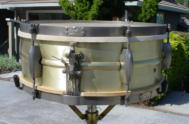
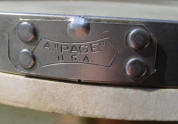

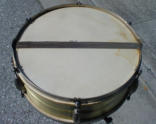
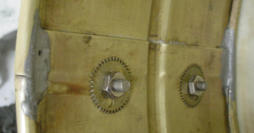
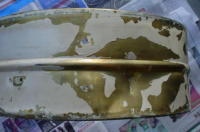
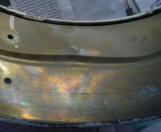
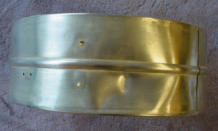
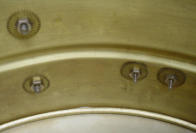
*The first reference to a finish option other than the “standard” nickel over brass or natural wood shell with nickel plated
fittings is in catalog “G” from circa. 1921-22. This first finish option is introduced as the “New Inspiration Model” with the
following description.
“ The shell is made of spun brass, gunmetal finish: the counter hoops and snare strainer are gold plated, a combination that
has a most attractive appearance.”
The “Inspiration” model could be had in any of the available sizes by adding the letter “A” after the size number. At the
same time Ludwig & Ludwig also offered an all Gold Model, assigning the letter “B” to that option. (shell and fittings plated
in real gold)
The third option offered was the DeLuxe Model with the DeLuxe finish. This finish option was introduced between 1922
and 1923. The DeLuxe Model is the “Hand Engraved-Gunmetal Finish,” (what we know today as the “Black Beauty.”) The
shell is “hand engraved in a beautiful scroll design on gunmetal finish.” “The rods, lugs and counter-hoops are special
plated with the Ludwig DeLuxe Finish that resembles real gold yet wears better.”
Try not to confuse the DeLuxe Model with the DeLuxe finish. The DeLuxe finish refers to plating on the fittings and was an
option available on several other models as well.
Thank you Bill Wanser!
**Bill's right on target if you only go by catalog dates. The one thing Ludwig was consistent about through the years and still
does, is to put items in the catalog after they are in production. Since they didn't do a catalog every year, it's safe to assume
that new items were added every year. I agree with the 1923 "official" cutoff date for six lug bb's, but not his reasoning for
specific dating at 21 or 22. The only feature on this drum that would date it earlier would be a "patent applied for" instead of
pat pend. on the P-338 strainer. Those flat hoops were replaced with single flanged hoops before the switch to 8 lugs in
1923. If your drum had single flange hoops, I'd go along with Bill. I've seen patent applied for stamps on six-luggers with
single flange hoops too. I'm going to stick with 1919-1921.
And there's more from John...
Hey Bill and Mike,
You (Bill) hit the nail on the head with your last word (speculating). But it is fun to try and take all the clues and speculate. In
the end, no one really knows, because it's just as possible that a drummer swapped hardware on the drum at some point,
either for preference or to replace a broken part. It's nice to think I know something about all this, but in the end, the
ballpark answer is the only right one that can't be argued with. Or to quote Bill "sometime between catalog "G" (1919
maybe?) and the 1923 catalog they started producing the DeLuxe model"! That I can agree with unconditionally.
Thank you John Aldridge!
Hey, what's three years amongst friends anyway?
The Shell:
The heavy 2-pc. shell is in pretty good shape for a 90+ year old drum. There were a few minor dings and dents that I was
able to smooth out pretty easily. The gunmetal finish and scroll engraving is pretty well preserved thanks to the clear
lacquer coat. I did lightly clean and polish the clear lacquer and was happy with the outcome. The shell came back to life.
There is no "Ludwig Chicago" shell engraving that we would soon see in the top panel just left of the P-338 strainer on later
6 lug and 8 lug DeLuxes. The top rim does have the oval "Ludwig & Ludwig Chicago" stamp, so all is good.
The Hardware:
It looks like all of the original hardware is present and accounted for with exception of one tension rods washer, an easy fix.
The DeLuxe-finished hardware shows its age a bit more than the shell, especially the top and bottom rims. One of the
trickiest areas of restoration is dealing with steel flat band rims. It really doesn't matter what the plating is, the real problem
is that the base metal is steel. I'm not sure if it starts at the factory or if it is simply just the elements of time but most of
these late teens/early 1920s steel flat band rims that I've dealt with are rusted through to the finish as is the case with at
least 75% of the top and bottom rims on this drum. This leaves us 3 options to deal with : 1. Re-plating. 2. Doing some type
of cleaning, preservation or restoration. 3. Leaving everything as is. We all know that rust does not sleep so I usually stick
with option #2. I cleaned both rims, got as much of the rust off as I could without ruining the existing DeLuxe finish and then
I added a few coats of Nicolas #2105 Special Gold Lacquer spray to hopefully seal and preserve whatever DeLuxe finish
was left. The brass hardware is a little easier to deal with because where ever the original gold lacquer has worn away the
original copper plating has just tarnished making it very easy to get the tarnish off and to polish (Cape Cod Polishing
Cloths) those areas where the original copper was exposed. After a shot or two of the aforementioned gold spray, the lugs,
collar hooks, tension rods/washers, P-338, and butt plate all came back to life but still look their age.
Of-the-era top and bottom calf heads and silk-wound snares rounded out this restoration.
As a note of comparison I added a photo of this drum with a later model 6 lug 5x14 DeLuxe that has single-flanged rims
and the "Ludwig Chicago" engraving in the same panel where the P-338 strainer is located.
Some observations:
NB: All of the parts on this drum are shown at the bottom of the photos.
1. Different lug used on 6 and 8 lug DeLuxes and other models vs. 10 lug DeLuxes and other models. Same c-c hole
spacing but both ends "eyelets" and "bases" of the lugs on this 6 lug DeLuxe are different than that of later models.
2. Noticeable difference (cruder looking) in the manufacturing of the 8-32 lug attachment screws on this drum vs. later
models.
3. Nickel over brass cup washers used on 6 and 8 lug DeLuxes (and other models), raw brass cup washers used on 10 lug
DeLuxes and later models. L&L's way of cutting plating costs?
4. Different tension rods used on the early DeLuxes vs. later DeLuxes.
5. Different style (longer lip) collar hooks used on 6 lug DeLuxes and other models, shorter "lips" on later models.
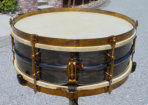
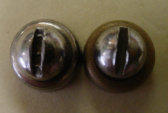
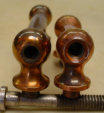
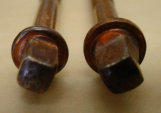
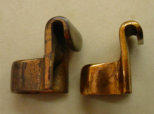
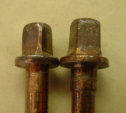
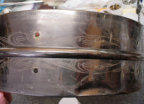
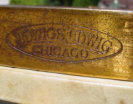
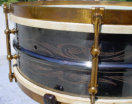
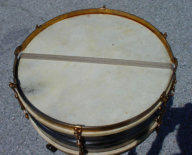
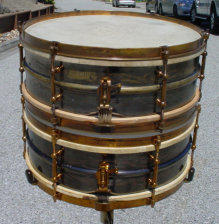
Curotto Collection - Page 3

The best way to communicate with Jim is via E-mail to: savoldi1@aol.com

Curotto Collection
*The Broadcaster Model was very short-lived so for those of you that may not be familiar with this model here is a short history
and background data regarding the Slingerland Broadcaster Model. The following is from Rob Cook's Slingerland Book
(first edition): "The Broadcaster was evidently a forerunner of the Radio King, the strainer is a very early Radio King style
strainer and the lugs do not have inserts. (The tension rods thread directly into the lugs.) The muffler was the single-pad style
Harold R. Todd muffler." Thanks again to Rob Cook. I have also read that Slingerland was legally forced to discontinue using
the word "Broadcaster" (with a "c") as the Fred Gretsch Co. had been using the name "Broadkaster" (with a "k") on their drums
way before Slingerland and therefore the court ruled in favor of Gretsch that Slingerland's Broadcaster was too close
sounding/looking to Gretsch's Broadkaster.
The Shell:
This all original drum was already in great shape but I still wanted to add my finishing touch to it. The nob shell had a few very
small dents that were easy to fix. The area where both of the snare bridges are attached to the shell was a tad bent in so I
smoothed everything out with my trusty hammer. Mark had already done a nice polishing job on the shell so I just went over
the shell with a clean cloth to remove any finger prints, left over rouge and assorted smudges. All in all, the shell came out great
but it still looks its correct age. Both snare bridges are identical meaning that the butt side is not drilled for that tightening plate
that you would normally see on the soon to follow Radio King models but instead there is a centered hole approximately 1/8"
above the bead where what looks like a center post for a 1920s-30s bass drum is attached and this is where the snare cord
attaches to keep the wires tensioned on the butt side of the drum. This center post has a smaller diameter than the post of a
double post tube lug so that is why I think it is an older bass drum center post. The washer is my idea as the knots tighten better
with the washer. At first I thought that this was a crude after market addition but with a little research I've found two more
examples of wood Broadcasters with this exact same set up. My guess is that my drum is an earlier Broadcaster because I also
own two other wood Broadcasters with butt side snare bridges that are drilled and do have the tensioning plates. That's just my
logical guess, so feel free to weigh in if you have anything else to add to this. As a final observation, I noticed on my 1936
Slingerland nob Radio King that there is a similar hole that is centered 1" above the bead at the butt plate side of the shell, this
is obviously an air hole but the similarity is still there. The air hole on the Broadcaster is one panel to the right of the butt side
snare bridge and 1" above the bead.
The Hardware:
All of the nob hardware was clean and in great shape but I still did my cleaning and polishing routine. The tapped (no inserts)
Streamline lugs are chrome plated and are in decent shape. I know for some reason, on occasion, that Slingerland outfitted their
snare drums with nickel plated hardware and chrome plated Streamline lugs. I've seen this on numerous drums and I am well
aware that this is correct but it still bugs the hell out of me as I like stuff that matches. So in the interest of a faithful preservation,
I've left the Streamline lugs as is on this snare drum but I was holding my nose all the way through as I reassembled the drum.
The top rim has a nice deep cut Slingerland Broadcaster logo and the bottom rim has the usual "manufacturer's cartouche" at
both ends where the snare gates attach. Another observation that I have noticed on my other Broadcaster and DuAll Models
has to do with these "manufacturer's cartouches". One end of the bottom rim where the gate attaches and one gate will have
only one stamped letter, e. g. "D", while the other end of the rim will have two stamped letters, e. g. "D D" as does the other
gate, so "D" matches "D" and "D D" matches "D D". Both gates are identical, fit perfectly and are interchangeable on either
side. So another question arises; what is the reason for the single vs. double stamping if both sides are identical?
A nice pair of era-correct calf heads and snare wires rounded out this cleaning/restoration.
I have added a few photos of my 1936 6.5 x 14 nob Radio King so you can see the similarities and differences of these two
closely related drums.
Enjoy!













